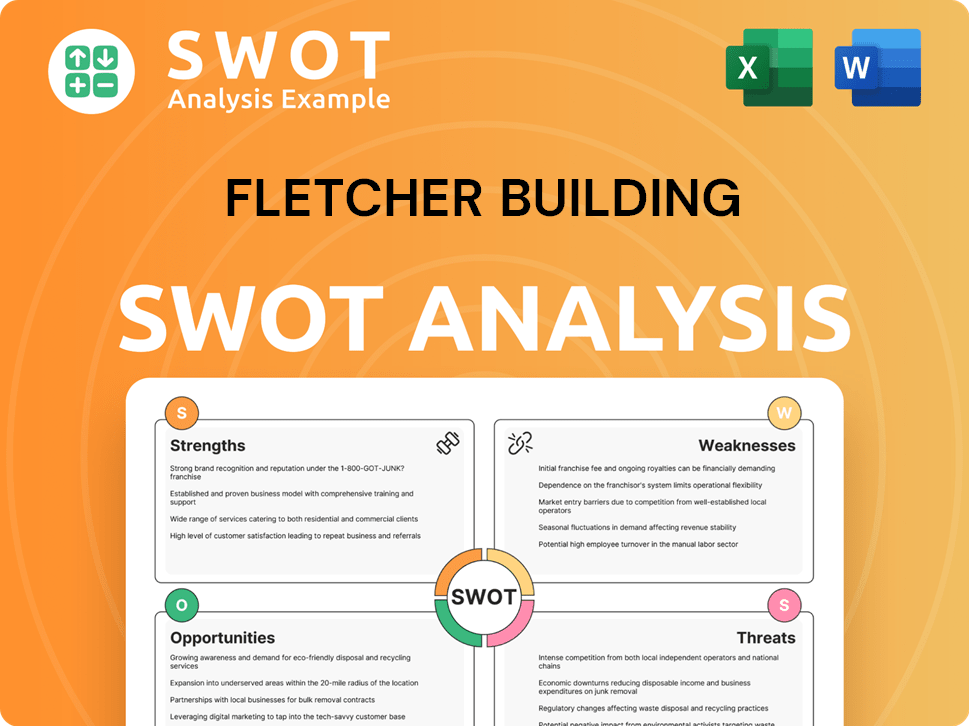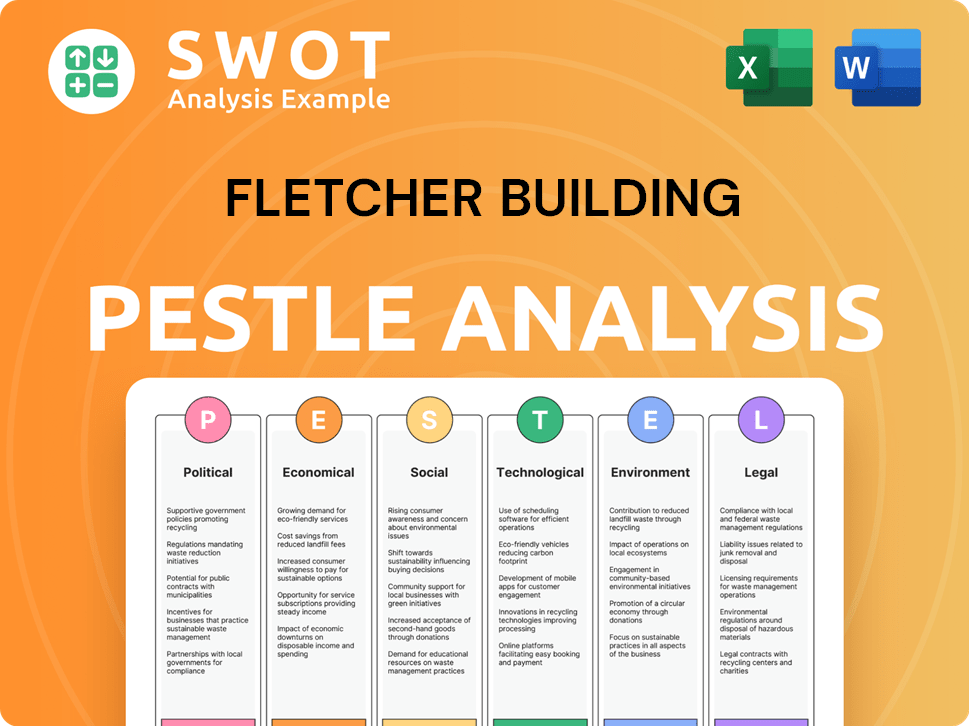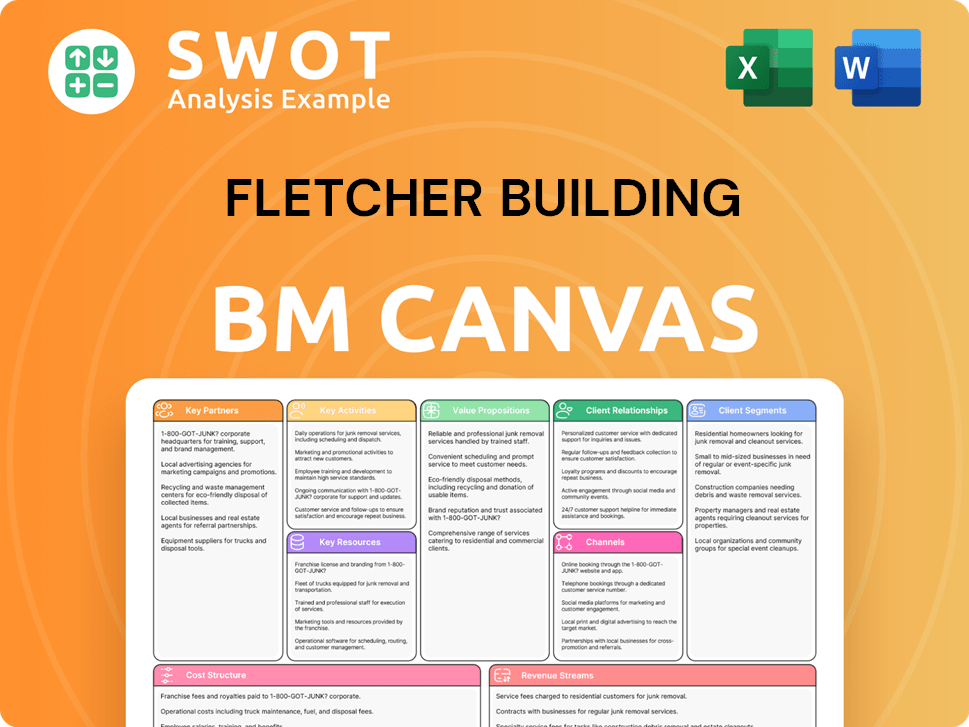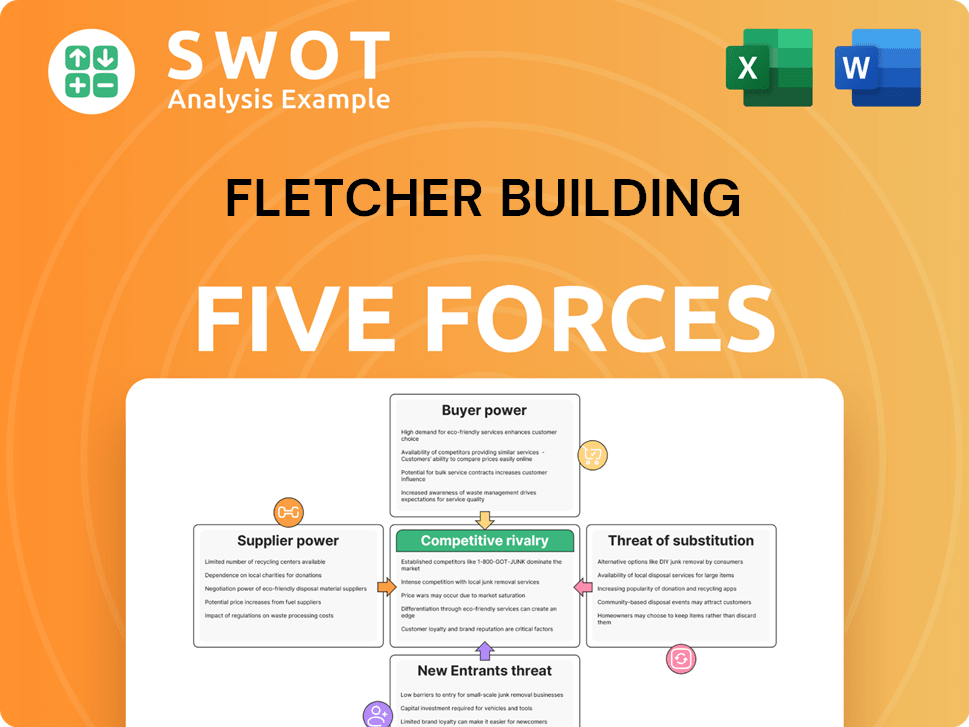Fletcher Building Bundle
Who Really Controls Fletcher Building?
Understanding the Fletcher Building SWOT Analysis is just the beginning; the true power dynamics within Fletcher Building Company lie in its ownership structure. A recent NZ$700 million equity raise highlights how shifts in ownership can reshape a company's financial health and future prospects. For investors and stakeholders, knowing who owns Fletcher Building is paramount to navigating the complexities of this major player in the construction and building materials sector.

From its humble beginnings in 1909, Fletcher Building has evolved into a significant force in the New Zealand and Australian markets. This exploration into Fletcher Building ownership will cover its journey from its founders to its current state as a publicly traded entity. We'll examine the major shareholders, the influence of the Board of Directors, and recent trends that are shaping the future of Fletcher Building NZ. The current owner of Fletcher Building and the company's structure are key to grasping its strategic direction.
Who Founded Fletcher Building?
The story of Fletcher Building begins with James Fletcher senior, a Scottish builder and stonemason. He initiated the business in 1909 alongside Albert Morris, marking the start of what would become a major construction and building materials company.
Initially, the company faced challenges, including a loss on its first project. However, the business was revitalized in January 1911 with the addition of James's brother, William John Fletcher, as an equal partner. This partnership laid the groundwork for future expansion and the evolution of Fletcher Building ownership.
The company's structure evolved over time, starting with a focus on the founding family. The early ownership arrangements were critical in shaping the company's direction and growth within the construction industry. The company's journey reflects a transition from a small building firm to a publicly listed entity, demonstrating the evolution of its ownership and corporate structure.
The company's early years saw significant changes in its structure and ownership. The incorporation of Fletcher Bros Ltd in 1915 and the later transition to Fletcher Construction Company Ltd were pivotal moments. The listing of Fletcher Holdings on the share market in 1940 marked a major shift in its ownership profile, opening up opportunities for wider investment and influencing the company's trajectory.
- The initial partnership between James Fletcher and William John Fletcher established a foundation of equal ownership.
- The departure of Albert Morris led to the renaming of the company to Fletcher Brothers in May 1912.
- The incorporation of Fletcher Bros Ltd in 1915 formalized the company's structure.
- The listing of Fletcher Holdings on the share market in 1940 was a key step in its evolution.
Fletcher Building SWOT Analysis
- Complete SWOT Breakdown
- Fully Customizable
- Editable in Excel & Word
- Professional Formatting
- Investor-Ready Format

How Has Fletcher Building’s Ownership Changed Over Time?
The ownership structure of the company, now known as Fletcher Building, has evolved significantly since its inception. A pivotal moment occurred in 2001 when the company, previously the largest business in New Zealand under the name Fletcher Challenge, was restructured. This led to the creation of focused entities, with Fletcher Building Limited being listed on the NZX and ASX. The initial public offering (IPO) took place on July 25, 1999.
As of June 11, 2025, the market capitalization of Fletcher Building stands at NZ$3.26 billion, reflecting its current valuation and the impact of market dynamics on its ownership structure. The company's journey from a conglomerate to a focused building materials and construction entity has shaped its shareholder base, attracting a mix of institutional and individual investors.
| Key Dates | Event | Impact on Ownership |
|---|---|---|
| 1999 | IPO | Transition from private to public ownership, opening shares to a wider investor base. |
| 2001 | Restructuring of Fletcher Challenge | Formation of Fletcher Building as a separate entity, with its own shareholding structure. |
| June 11, 2025 | Market Capitalization Update | Reflects the current value of the company and the collective assessment of its ownership by the market. |
Institutional investors currently hold a significant portion of Fletcher Building's shares. As of May 14, 2025, there are 76 institutional owners and shareholders, collectively holding 59,198,243 shares. Key institutional shareholders include Vanguard Developed Markets Index Fund Admiral Shares (VTMGX), iShares Core MSCI EAFE ETF (IEFA), Avantis International Small Cap Value ETF (AVDV), and iShares MSCI EAFE Small-Cap ETF (SCZ). These holdings indicate a strong level of institutional confidence in the company. For a deeper dive into the company's approach, check out the Marketing Strategy of Fletcher Building.
Changes in shareholding are ongoing, reflecting market adjustments and investor decisions. These shifts can influence market perception and investor confidence.
- Schroder Investment Management Limited reduced its voting power from 10.24% to 6.158% between October 2024 and May 2025.
- Orbis Investment Management Limited held 17.03% of shares as of September 29, 2024.
- The 2024 Annual Report listed significant shareholders such as Citicorp Nominees Pty Limited (11.72%), and HSBC Custody Nominees (Australia) Limited (8.91%).
Fletcher Building PESTLE Analysis
- Covers All 6 PESTLE Categories
- No Research Needed – Save Hours of Work
- Built by Experts, Trusted by Consultants
- Instant Download, Ready to Use
- 100% Editable, Fully Customizable

Who Sits on Fletcher Building’s Board?
The Board of Directors is central to the governance and strategic direction of Fletcher Building. As of February 2025, Peter Crowley holds the position of Chair. Furthermore, Jacqui Coombes serves as an independent, non-executive director. In addition, James Miller is set to join the board as an independent non-executive director, with his role commencing on June 1, 2025. Sandra Dodds, currently a member of the Audit and Risk Committee, has been appointed as the Chair of that committee, and Cathy Quinn is the Chair of the Safety, Health, Environment, and Sustainability Committee. This structure reflects the company's commitment to strong governance and oversight, which is crucial for addressing the challenges and opportunities in the current market environment. Understanding the Target Market of Fletcher Building is vital for appreciating the context of these governance decisions.
The composition of the board has seen recent changes, reflecting the dynamic nature of the company's operations and the need for strategic adaptation. These appointments and committee assignments highlight the company's focus on enhancing its governance framework and ensuring effective oversight across key areas of the business. The board's decisions are critical for navigating the company's strategic priorities and ensuring its long-term success. This includes managing shareholder expectations and responding to market dynamics effectively.
| Position | Name | Date of Appointment/Change |
|---|---|---|
| Chair | Peter Crowley | February 2025 |
| Independent, Non-Executive Director | Jacqui Coombes | February 2025 |
| Independent, Non-Executive Director | James Miller | June 1, 2025 |
| Chair, Audit and Risk Committee | Sandra Dodds | February 2025 |
| Chair, Safety, Health, Environment and Sustainability Committee | Cathy Quinn | February 2025 |
Fletcher Building operates with a one-share-one-vote structure for its ordinary shares, ensuring that each share held by Fletcher Building shareholders carries equal voting rights. Shareholders are entitled to full voting rights and receive dividends based on their share ownership. Shareholders registered as holders of ordinary shares as of the close of trading on Monday, October 21, 2024, were eligible to vote at the Annual Shareholders' Meeting held on October 23, 2024. Shareholders have the option to vote by postal vote or to appoint a proxy, including the Chair or any director, to vote on their behalf. This structure supports broad shareholder participation and engagement in the company's decision-making processes. The Annual Shareholders' Meeting in October 2024 saw a high level of attendance, indicating the considerable interest of Fletcher Building shareholders.
Shareholders of Fletcher Building have significant influence through their voting rights.
- One-share-one-vote structure ensures equal voting power.
- Shareholders can vote in person, by postal vote, or by proxy.
- Annual Shareholders' Meetings are key forums for shareholder engagement.
- Increased shareholder scrutiny has led to board changes and accountability.
Fletcher Building Business Model Canvas
- Complete 9-Block Business Model Canvas
- Effortlessly Communicate Your Business Strategy
- Investor-Ready BMC Format
- 100% Editable and Customizable
- Clear and Structured Layout

What Recent Changes Have Shaped Fletcher Building’s Ownership Landscape?
Over the past few years, significant shifts have occurred in the ownership and strategic direction of Fletcher Building. In September 2024, the company announced plans to raise NZ$700 million to strengthen its balance sheet. This included an institutional entitlement offer and a placement. The institutional component successfully raised approximately NZ$593 million, with eligible institutional shareholders taking up 91% of the offer. This equity raise contributed to reducing the company's debt-to-equity ratio, which improved from 1.07 in June 2024 to 0.74 as of December 2024.
Fletcher Building has also been actively reviewing its strategic options, including potential divestments. In September 2024, there were reports of the company considering divesting its residential and development unit and seeking capital from investors. By June 2025, the company confirmed receiving 'ongoing inbound inquiries' from parties interested in purchasing its businesses, including the construction division. While no decisions have been made to sell any businesses, the company plans to provide more details at an investor day on June 24, 2025. The sale of its Australian plumbing supplies and distribution business, Tradelink, for NZ$186 million in August 2024, further reflects these strategic moves.
| Metric | June 2024 | December 2024 |
|---|---|---|
| Debt-to-Equity Ratio | 1.07 | 0.74 |
| Tradelink Sale (NZ$ million) | - | 186 |
| Institutional Offer (NZ$ million) | - | 593 |
These developments indicate a focus on streamlining operations and enhancing financial resilience. The company is also planning to cut NZ$200 million in costs in the 2025 full year. Market volumes for materials and distribution businesses are expected to be 10-15% lower in FY25 compared to FY24. Industry trends suggest increased institutional ownership, a common characteristic for publicly traded companies like Fletcher Building. Leadership changes, with Andrew Reding becoming Group Chief Executive Officer and Managing Director in August 2024, also highlight the evolving landscape of Fletcher Building ownership and management.
Fletcher Building raised NZ$700 million to bolster its financial position, improving the debt-to-equity ratio.
The company is exploring potential divestments, including parts of its construction division, to streamline operations.
Plans to cut NZ$200 million in costs for the 2025 full year reflect an emphasis on efficiency and financial health.
Market volumes are expected to be lower in FY25, prompting strategic adjustments and operational improvements.
Fletcher Building Porter's Five Forces Analysis
- Covers All 5 Competitive Forces in Detail
- Structured for Consultants, Students, and Founders
- 100% Editable in Microsoft Word & Excel
- Instant Digital Download – Use Immediately
- Compatible with Mac & PC – Fully Unlocked

Related Blogs
- What are Mission Vision & Core Values of Fletcher Building Company?
- What is Competitive Landscape of Fletcher Building Company?
- What is Growth Strategy and Future Prospects of Fletcher Building Company?
- How Does Fletcher Building Company Work?
- What is Sales and Marketing Strategy of Fletcher Building Company?
- What is Brief History of Fletcher Building Company?
- What is Customer Demographics and Target Market of Fletcher Building Company?
Disclaimer
All information, articles, and product details provided on this website are for general informational and educational purposes only. We do not claim any ownership over, nor do we intend to infringe upon, any trademarks, copyrights, logos, brand names, or other intellectual property mentioned or depicted on this site. Such intellectual property remains the property of its respective owners, and any references here are made solely for identification or informational purposes, without implying any affiliation, endorsement, or partnership.
We make no representations or warranties, express or implied, regarding the accuracy, completeness, or suitability of any content or products presented. Nothing on this website should be construed as legal, tax, investment, financial, medical, or other professional advice. In addition, no part of this site—including articles or product references—constitutes a solicitation, recommendation, endorsement, advertisement, or offer to buy or sell any securities, franchises, or other financial instruments, particularly in jurisdictions where such activity would be unlawful.
All content is of a general nature and may not address the specific circumstances of any individual or entity. It is not a substitute for professional advice or services. Any actions you take based on the information provided here are strictly at your own risk. You accept full responsibility for any decisions or outcomes arising from your use of this website and agree to release us from any liability in connection with your use of, or reliance upon, the content or products found herein.